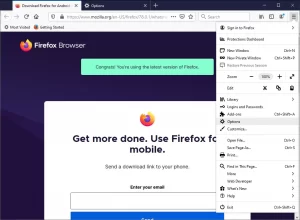Although Google Chrome has monopolized the world of browsers, Firefox is one of the best alternatives to Chrome. However, Firefox also has its problems, such as slow speeds. In addition, updates or automatic updates of Firefox annoy users of this browser.
Automatically updating your browser is annoying when you work with a browser that looks so fancy and beautiful, has so many great extensions, and is safe. Although there are many reasons for these automatic updates, you can learn how to control them and prevent automatic Firefox updates.
How to disable Firefox auto-update
Depending on your Firefox browser version, there are several ways to enable or disable automatic updating of this browser. In addition, there is a version of Firefox ESR, which is mostly used by companies that do not receive feature updates.
Mozilla Firefox browser gets security updates, Ensuring your secure internet connection. However, the user interface of other versions may not be very interesting for companies that do not receive updates, so they prefer to use the Firefox ESR version.
Although disabling Firefox auto-update is a bit difficult, there are powerful solutions you can use to disable auto-updates.
1- Using the options of the Firefox auto-update section
You can disable its automatic update using the Firefox settings or options section. This means that your browser is checking for updates, But you leave the installation to yourself to update Firefox if you wish. So keep in mind that this method does not disable update notifications.
To use this method, follow these steps:
- Launch the Firefox browser on your computer. Then in the upper right corner of the browser window, click on “Open Menu” and select “Options.”

- Under the General tab, go to the “Firefox Updated” section at the bottom of the page.
- Select “Check for Updates but let you choose to install them.” Then uncheck “Use a background service to install updates.” This way, from now on, the Firefox update pop-up windows will be shown to you, and you can install them if you wish.
Note that Firefox will still remind you several times for updates after using this method and ask you to download them. To prevent downloading these updates, you must click on the “Not Now” option when you are reminded of a new update.
2. Use the Firefox Enterprise Policies option
If you are good at using quick tricks, you can use this option. This will require a Firefox update to run on system permissions. This method is best used for Windows and Firefox users version 63 and above.
To do this, follow these steps:
Close all windows running Firefox on your computer and open the Firefox installation folder.
If you are running Windows, open drive C and find the list of programs. Then open the Mozilla Firefox installation menu. Instead, you can right-click on the Firefox shortcut icon on your computer and select “Open file location.”
Under the installation folder, create a subdirectory/subfolder and name it “distribution.”
Then create a JSON file on the desktop and name it Policy.json. You must save the file as a JSON file with this code. You can use Notepad on your PC to create a folder or use a code editor like Notepad ++.
Copy the created policy.json file under the “distribution” directory. Close the installation. Now open the Firefox Updates section of Firefox to see if this method works.
3- Using Regedit
Like the previous method, this solution is a bit long; But it gets you what you want. This method uses the registry editor program on your computer. To use this solution, follow these steps:
- Close Firefox.
- Open the Run window using the “Win + R” keys.
- Enter “Regedit” and then “OK” to open it.
Follow this critical path, “HKEY_LOCAL_MACHINE \ Software \ Policies.” Create a subkey under the policies key and name it “Mozilla.” Under this key, create a new subkey and name it “Firefox.” The new key path should be: “HKEY_LOCAL_MACHINE \ Software \ Policies \ Mozilla \ Firefox.”
Right-click on a space to create a DWORD (32-Bit) Value on the right. Name it “DisableAppUpdate”.
Open the input and set “Value data” to 1. Click “OK” to confirm.
You can check the Firefox Updates section to check for changes. This section should be displayed as “Updates disabled by your system administrator.”
How to check for Firefox updates manually?
Sometimes you may need to use a specific update. In this case, you can manually check Firefox and view the update. Disabling auto-updates does not restrict the installation of updates.
Follow the steps below to install Firefox updates manually:
In your Firefox browser, click “Menu” and select “Help.”
Then select “About Firefox.” In this case, the Firefox browser update window should open for you. If your browser is up to date, there is no option.
Why not turn off updates?
Although updating Firefox makes most websites and plugins unusable, keeping your information secure is very important. So before doing anything, make sure that your computer is protected against cybercriminals. You can also use alternative options for your plugins.
Updates come with added security features and stable functionality to help developers implement software fixes. So it can be said that frequent updates are a good thing.
Conclusion
With the methods mentioned in this article, you can disable the automatic Firefox update. However, we still recommend that you keep your browser up to date and install updates to protect your data from security risks. Using the Firefox Auto-updates option in the options menu may be convenient. However, Enterprise Policies and regedit methods can completely disable Firefox updates if you need to limit update notifications.